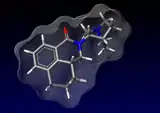Palonosétron
Le palonosétron (DCI, nom commercial: Aloxi) est un antagoniste 5HT3 utilisé dans la prévention et le traitement de chimiothérapie induisant nausées et vomissements. Il est le plus efficace des antagonistes 5-HT3 concernant le retardement des nausées et des vomissements, ceux-ci apparaissent au-delà des 24 heures qui suivent la première dose d'un traitement de chimiothérapie, et est le seul médicament de sa catégorie à avoir été approuvé par Food and Drug Administration[2]. En 2008, il est le plus récent antagoniste 5-HT3 à utilisation clinique.
| Palonosétron | ||

| ||
 | ||
| Identification | ||
|---|---|---|
| Nom UICPA | (3aR)-2-[(3S)-1-azabicyclo[2.2.2]oct-3-yl]-2,3,3a, 4,5,6-hexahydro-1H-benz[de]isoquinolin-1-one |
|
| No CAS | ||
| Code ATC | A04 | |
| DrugBank | APRD00351 | |
| PubChem | 6337614 | |
| ChEBI | 651486 (HCl) | |
| SMILES | ||
| InChI | ||
| Propriétés chimiques | ||
| Formule | C19H24N2O [Isomères] |
|
| Masse molaire[1] | 296,406 7 ± 0,017 6 g/mol C 76,99 %, H 8,16 %, N 9,45 %, O 5,4 %, |
|
| Unités du SI et CNTP, sauf indication contraire. | ||
Le palonosétron est administré soit par voie intraveineuse, une seule dose, 30 minutes avant la chimiothérapie, soit comme une seule gélule par voie orale une heure avant la chimiothérapie[3]. La voie orale a été approuvée le pour la prévention de graves problèmes de chimiothérapie induisant nausées et vomissements[3].
Pharmacocinétique
Il a une demi-vie plus longue et une affinité plus importante avec le récepteur 5-HT3 que les antagonistes 5HT3 plus anciens. Cette propriété d'antagonisme est de type allostérique[5].
Efficacité
Il s'avère être supérieur au dolasétron[6] ou à l'ondansétron[7] dans la prévention des nausées ou vomissements tardifs après une chimiothérapie anticancéreuse. En association avec un corticoïde, il s'avère également meilleur que le granisétron[8]. Le traitement corticoïde peut d'ailleurs être écourté sans perte d'efficacité[9].
Notes et références
- Masse molaire calculée d’après « Atomic weights of the elements 2007 », sur www.chem.qmul.ac.uk.
- (en) De Leon A, « Palonosetron (Aloxi): a second-generation 5-HT(3) receptor antagonist for chemotherapy-induced nausea and vomiting », Proceedings (Baylor University. Medical Center), vol. 19, no 4, , p. 413–6 (PMID 17106506)
- (en) Waknine, Yael, « FDA Approvals: Nplate, Aloxi, Vidaza », Medscape, (consulté le )ly available with registration.
- Rojas C, Stathis M, Thomas AG et al. Palonosetron exhibits unique molecular interactions with the 5-HT3 receptor, Anesth Analg, 2008;107:469-478
- Eisenberg P, Figueroa-Vadillo J, Zamora R et al. Improved prevention of moderately emetogenic chemotherapy-induced nausea and vomiting with palonosetron, a pharmacologically novel 5-HT3 receptor antagonist: results of a phase III, single-dose trial versus dolasetron, Cancer, 2003;98:2473-2482
- Gralla R, Lichinitser M, Van Der Vegt S et al. Palonosetron improves prevention of chemotherapy-induced nausea and vomiting following moderately emetogenic chemotherapy: results of a double-blind randomized phase III trial comparing single doses of palonosetron with ondansetron, Ann Oncol, 2003;14:1570-1577
- Saito M, Aogi K, Sekine I et al. Palonosetron plus dexamethasone versus granisetron plus dexamethasone for prevention of nausea and vomiting during chemotherapy: a double-blind, double-dummy, randomised, comparative phase III trial, Lancet Oncol, 2009;10:115-124
- Aapro M, Fabi A, Nolè F et al. Double-blind, randomised, controlled study of the efficacy and tolerability of palonosetron plus dexamethasone for 1 day with or without dexamethasone on days 2 and 3 in the prevention of nausea and vomiting induced by moderately emetogenic chemotherapy, Ann Oncol, 2010;21:1083-1088
- Portail de la médecine
- Portail de la pharmacie